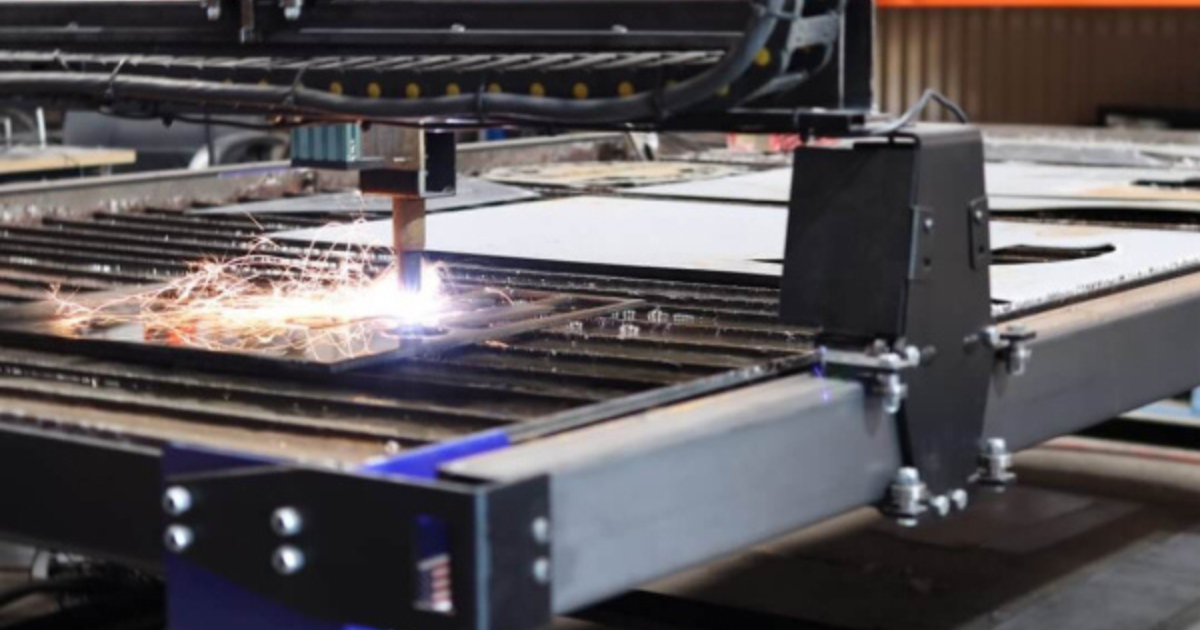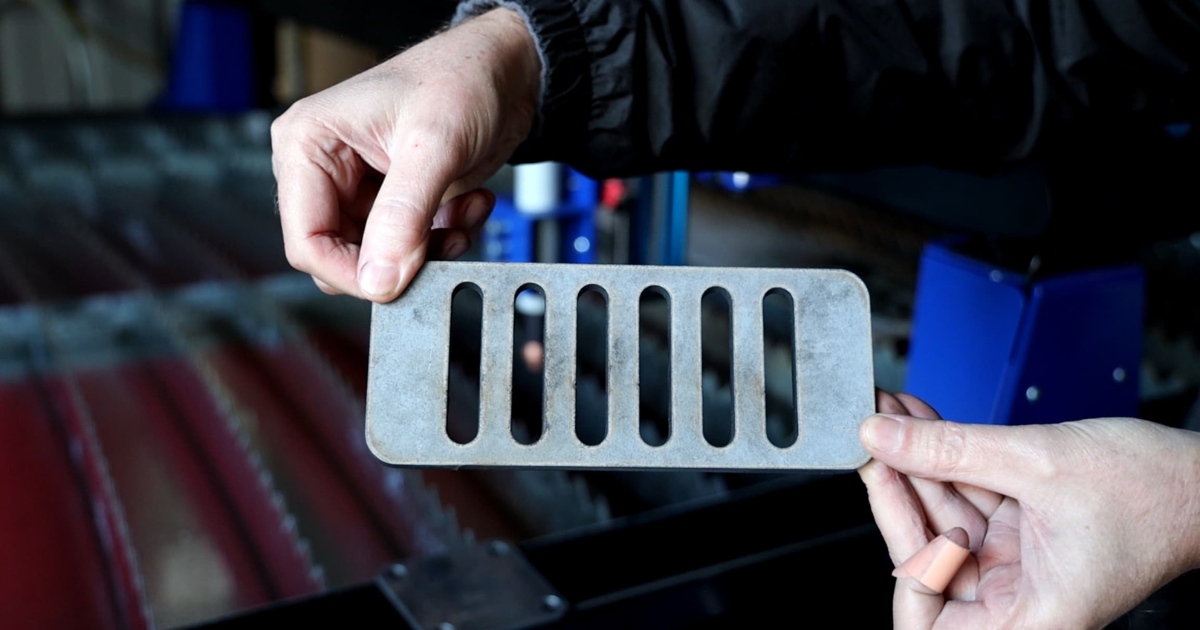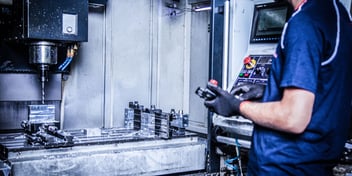What is high-definition (HD) plasma cutting?
When purchasing a new precision cutting machine, you need full confidence that it’s the best tool for the job. While plasma cutters have been around for years, recent technological advances have allowed plasma cutters to achieve even more accuracy and definition on a range of materials and thicknesses.
In this article, we discuss the capabilities of high-definition plasma cutters and share all the advantages they provide.
The basis of HD plasma cutting
Plasma cutting machines are used to cut electrically conductive materials like steel, aluminium, brass, and copper. A jet of extremely hot plasma is accelerated through the torch at a high velocity and density. The plasma burns oxygen and electrical energy and the nozzle creates a cylindrical arc, which cuts the workpiece.
Historically, the first plasma-cutting machines were limited in terms of power output and cutting capacity, only able to cut steel up to a quarter of an inch thick. Over time, as technology evolved, the power output on these machines increased, allowing thicker materials to be cut with the signature plasma cutting precision.
Today, high-definition plasma cutters, or HD plasma cutters, can cut 75mm mild steel at 400 amps or 150mm aluminium at 800 amps. These machines also offer a lower cost per cut, higher cut accuracy, easier system usage, and higher levels of productivity.
There are two components to achieving a high-definition cut; the plasma power source itself, and also the cutting table that controls the motion of the cutting torch.
A typical “high definition” plasma cutting power source differs from a standard “air-shielded” plasma cutter, in the following ways;
- Cutting gas - whilst a standard plasma cutter uses only compressed air to cut, an HD plasma cutter uses a combination of gases in addition to compressed air, such as oxygen and nitrogen. The gas can also be split as well, so that a different gas is utilised for piercing, cutting and shielding to achieve a much higher definition cut, with much less angularity (or taper).
- Plasma arc starting - high-definition machines use high frequency to start the arc, and sometimes during the cutting process as well.
- Output - typically, HD plasma machines have a much higher amperage output than traditional air-shielded machines. Amperages ranging from 200 to 600 amps are quite common, whilst standard plasma machines mainly operate at amperages less than 200amps.
To use a basic analogy, a powerful engine in a car does not, in isolation, immediately ensure the car is able to win a race. Other factors such as tyres, weight and aerodynamics are also important. In the same way, whilst the above technological advances work together to greatly enhance the cutting performance of HD plasma cutters, all these improvements would be in vain if other components such as the motion of the torch & the capacity of the cutting bed, has not also been improved. For example, the motors driving the machine should be powerful enough to accurately move the machine at the high speeds required. Also, the base or bed of the machine should be engineered so that it can handle the weight of thicker materials.
That said though, high-definition systems are substantially more expensive than traditional air-shielded systems. Starting prices are typically north of $200,000.
Do I actually need HD plasma for my application?
Definitely not! High definition certainly has its place due to its excellent precision, however when weighed up in terms of capital investment, in many cases a standard plasma system offers more than sufficient cutting results at a fraction of the investment.
Furthermore, there are middle-of-the-road solutions available, for example, the new K200 from Kjellberg Germany. The K200 is a simple yet robust 200 amp plasma machine, with a high frequency start as well as the option to use a range of different gases, not just compressed air. The addition of these features when combined with a robust machine table, helps the K200 deliver precision cutting to almost the same level as “high definition.”
Benefits of HD plasma cutting

Enhanced safety and automation
Our CNC software controls your plasma cutter, making it easier and smoother to operate. It’s also fully automated, making it more user-friendly and speeding up production. Whilst safety precautions are required, the plasma arc is not as dangerous as a laser beam and does not require covering during use.
Faster cutting times and improved efficiency
CNC machines are quick and easy to use, significantly increasing your team’s productivity. Compared to other cutting machines, such as lasers and water jets, CNC plasma machines also have a lower operating cost and are less complex.
HD plasma cutting capacity
With the right machine settings and thickness, you can use a plasma cutter to cut mild steel, stainless steel, steel alloys, aluminium, carbon steel, copper, and brass. The thickness that a CNC plasma cutter can cut is determined by the plasma and the CNC table.
Entry-level plasma machines may be suitable for cutting up to 12mm steel, while mid-range CNC plasma machines can cut up to 32mm thick steel. However, high-end industrial CNC plasma systems with high definition can cut steel plates up to 60mm thick and more.
However, most workshops in Australia don’t need to cut materials more than 32mm thick. In these cases, you may not need to invest in high-definition plasma, instead opting for smaller units that can still cut and pierce steel up to 32mm thick with good cut quality. You can use our product selector tool to find the right machine for your needs.
Precise, clean cuts
A quality HD plasma machine will dramatically improve your cut performance. With automated software, it’s easy to cut a wide range of metals in various shapes, thicknesses, and quantities.
Cost-effective
CNC plasma costs are relatively affordable, especially when compared to Laser and Waterjet. While our CNC Plasma Table packages start from $31,900, Waterjet and Laser equipment typically start at around $100,000+ for upfront costs, not to mention the running costs.
The initial investment for a CNC plasma cutter is a lot lower for thicker materials, making it a more accessible option for small to medium-sized businesses. You can get accurate pricing using our online price configurator here.
Compared to other cutting machines, CNC plasma cutters are more affordable to repair and maintain. If it breaks down, your HD plasma machine will be back up and running for a fraction of the cost.
Finance available
At Surefire CNC, we also partner with a finance provider to help you get the CNC machine you need. Our packages start from a finance cost of around $30 per day, based on a 5-year term.



